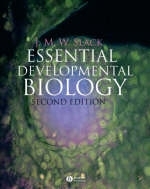
Essential Developmental Biology
Blackwell Publishing Ltd (Verlag)
978-1-4051-2216-0 (ISBN)
- Titel ist leider vergriffen;
keine Neuauflage - Artikel merken
Professor Jonathan Slack has worked in London and Oxford and is currently Head of the Department of Biology and Biochemistry at the University of Bath in England. He is a member of the European Molecular Biology Organization and a Fellow of the Academy of Medical Sciences. He is a leading authority in developmental biology and has published over 150 scientific papers, as well as the well-received monograph From Egg to Embryo and the lighthearted and popular Egg and Ego.
Preface. Section 1: Groundwork. 1 The excitement of developmental biology. Where the subject came from. Central position in biology. Impact on society. Future impact. 2 Common features of development. Genomic equivalence, cloning of animals. Gametogenesis. Early development. Morphogenetic processes. Growth and death. 3 Developmental genetics. Developmental mutants. Screening for mutants. Cloning of genes. Transgenesis. Gene duplication. 4 Experimental embryology. Normal development. Developmental commitment. Acquisition of commitment. Homeotic genes. Criteria for proof. 5 Techniques for the study of development. Microscopy. Study of gene expression by biochemical methods. Study of gene expression by in situ methods. Reporter genes. Microinjection. Cell-labeling methods. Cell sorting. Section 2: Major model organisms. 6 Model organisms. The big six. Availability and cost. Access and micromanipulation. Genetics and genome maps. Relevance and tempo. 7 Xenopus. Oogenesis, maturation, fertilization. Embryonic development. Experimental methods. Regional specification. Inductive interactions. 8 The zebrafish. Normal development. Mutagenesis. Regional specification. 9 The chick. Normal development. Regional specification of the early embryo. Description of organogenesis in the chick. 10 The mouse. Mammalian fertilization. Normal embryonic development. Technology of mouse development. Regional specification in development. Other topics in mouse development. 11 Drosophila. Insects. Normal development. Drosophila developmental genetics. Overview of the developmental program. The dorsoventral pattern. The anteroposterior system. 12 Caenorhabditis elegans. Normal development. Regional specification in the embryo. Analysis of postembryonic development. Programmed cell death. Section 3: Organogenesis. 13 Tissue organization and stem cells. Types of tissue. Tissue renewal. Skin. Intestine. Hematopoietic system. 14 Development of the nervous system. Overall structure and cell types. Anteroposterior patterning of the neural plate. Dorsoventral patterning of the neural tube. Neurogenesis and gliogenesis. The neural crest. Development of neuronal connectivity. 15 Development of mesodermal organs. Somitogenesis and myogenesis. The kidney. Germ cell and gonadal development. Limb development. Heart and blood vessels. 16 Development of endodermal organs. Normal development. Determination of the endoderm. The pancreas. 17 Drosophila imaginal discs. Metamorphosis. Genetic study of larval development. Mitotic recombination. Disc development. Regional patterning of the wing disc. Section 4: Growth, regeneration, and evolution. 18 Growth, aging, and cancer. Size and proportion. Growth in stature. Aging. Postnatal disorders of growth and differentiation. 19 Regeneration of missing parts. Distribution of regenerative capacity. Planarian regeneration. Vertebrate limb regeneration. 20 Evolution and development. Macroevolution. The primordial animal. What really happened in evolution? Appendix: Key molecular components. Genes. Transcription factor families. Signaling systems. Inducing factor families. Cytoskeleton. Cell adhesion molecules. Extracellular matrix components. Glossary. Index.
| Erscheint lt. Verlag | 16.9.2005 |
|---|---|
| Zusatzinfo | 797 illustrations |
| Verlagsort | Oxford |
| Sprache | englisch |
| Maße | 218 x 276 mm |
| Gewicht | 1180 g |
| Themenwelt | Naturwissenschaften ► Biologie ► Allgemeines / Lexika |
| Naturwissenschaften ► Biologie ► Genetik / Molekularbiologie | |
| ISBN-10 | 1-4051-2216-1 / 1405122161 |
| ISBN-13 | 978-1-4051-2216-0 / 9781405122160 |
| Zustand | Neuware |
| Haben Sie eine Frage zum Produkt? |
aus dem Bereich


